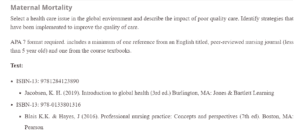Maternal Mortality
Although the reduction of maternal mortality is a key agenda of the Millennium Development Goals (MDGs), maternal death remains a public health menace in many regions worldwide. Globally, more than 300,000 mothers die from complications of pregnancy and childbirth (Stanton et al., 2018, p. 408). Critical quality shortcomings have been identified in health facilities that care for women during pregnancy, childbirth, and the post-natal period. Therefore, alongside the efforts to increase the availability of maternal health services, quality improvement measures are required in order to truly reverse high maternal mortality rates.
Impact of Poor Quality of Care
The shortage of essential maternal health supplies and products in healthcare facilities is a major quality concern in maternal care and a driver of maternal deaths. Although the coverage of maternal delivery services has increased in recent years, insufficient supplies, which limits access to essential health services among women who utilize these services, is still a major setback. Most facilities have insufficient products or experience frequent stock-outs of essential drugs such as uterotonics (Stanton et al., 2018, p. 409). Conceivably, a shortage of these medical supplies limits the ability of affected facilities to provide lifesaving treatment during critical obstetric events such as antepartum or post-partum hemorrhage. Under-resourcing is, therefore, a significant contributor to maternal mortality.
The shortage of a skilled maternal healthcare workforce also limits the ability of mothers to access timely quality care, hence contributing to maternal mortality. Many facilities are severely understaffed, particularly because of the lack of an adequate skilled midwifery workforce. Similarly, skilled birth attendants do not undergo adequate training in midwifery. Undertraining limits their ability to competently provide birth attendance (Campbell et al., 2016, p.127). Workforce shortages result in delays in the institution of required care or poor implementation of care. The ability to adhere to skilled birth attendance practices, such as active management of the third stage of labor, is key in preventing maternal death due to hemorrhage (Jacobsen, 2019, p.274). As a result, many mothers are at risk of succumbing to obstetric complications because they are unrecognized, recognized late, or poorly managed.
Poor quality of care also promotes maternal mortality by discouraging service utilization. The degree of utilization of maternal services, including pre-conception, antenatal, and perinatal care services by mothers, directly influences maternal outcomes. However, negative experiences of mothers when seeking maternal healthcare, such as non-responsive interpersonal care, maternal humiliation, and disrespectful treatment by health workers, adversely affect their perception of these services (Stanton et al., 2018, p.409). Therefore, their health-seeking behaviors are dampened. Negative perceptions driven by the poor quality of care derail their intention to seek maternal health services, putting them at risk of preventable birth complications because of unskilled birth attendance.
Quality Improvement Strategies
One strategy that has been implemented to reduce maternal death in health facilities is the near-miss initiative. This is a World Health Organization (WHO) initiative that enhances the quality of care by encouraging the early identification of women. The initiative encourages the use of scoring systems obtained from the clinical indicators of women who nearly succumbed to obstetric complications, such as indicators of organ failure, to identify and manage other at-risk women (Herklots et al., 2019, p.3). The initiative encourages a prevention approach to maternal death by promoting the identification of common pathways in poor maternal outcomes.
Similarly, increased professionalization of midwifery is being pursued in order to increase collaborative and team-based maternal care. The scopes of practice of midwives and other health professionals, such as nurses, physicians, and obstetricians, are being defined in order to forge a system of coordinated and continuing care for mothers (Campbell et al., 2016, p.127). Such workforce improvements are essential in reducing maternal mortality by integrating the expertise of midwives into the broader healthcare framework.
Maternal mortality is still a major global health menace, particularly in the world’s low- and middle-income regions. In recent years, interventions to reverse the trend have led to the implementation of strategies such as the ‘near miss’ initiative and professionalization of midwifery. However, additional quality improvement measures are required to address other contributors, such as shortage of supplies and low maternal satisfaction.
References
Campbell, J., Sochas, L., Cometto, G., & Matthews, Z. (2016). Evidence for action on improving the maternal and newborn health workforce: the basis for quality care. International Journal of Gynecology & Obstetrics, 132(1), 126-129. https://doi.org/10.1016/j.ijgo.2015.11.003
Herklots, T., van Acht, L., Khamis, R. S., Meguid, T., Franx, A., & Jacod, B. (2019). Validity of WHO’s near-miss approach in a high maternal mortality setting. PloS one, 14(5), e0217135. https://doi.org/10.1371/journal.pone.0217135
Jacobsen, K. H. (2019). Introduction to global health (3rd ed.) Burlington, MA: Jones & Bartlett Learning. https://books.google.co.ke/books?hl=en&lr=&id=qz__tpG7tuMC&oi=fnd&pg=PR1&ots=Ugkpa1Aize&sig=nI_lkxuRXF2bu7P1D5pMqUYML3k&redir_esc=y#v=onepage&q&f=false
Stanton, M. E., Kwast, B. E., Shaver, T., McCallon, B., & Koblinsky, M. (2018). Beyond the Safe Motherhood Initiative: Accelerated action urgently needed to end preventable maternal mortality. Global Health: Science and Practice, 6(3), 408-412. https://doi.org/10.9745/GHSP-D-18-00100
ORDER A PLAGIARISM-FREE PAPER HERE
We’ll write everything from scratch
Question 
Maternal Mortality
Select a health care issue in the global environment and describe the impact of poor quality care. Identify strategies that have been implemented to improve the quality of care.

Maternal Mortality
APA 7 format required. includes a minimum of one reference from an English titled, peer-reviewed nursing journal (less than 5 year old) and one from the course textbooks.
Text:
- ISBN-13: 9781284123890
- Jacobsen, K. H. (2019). Introduction to global health (3rd ed.) Burlington, MA: Jones & Bartlett Learning
- ISBN-13: 978-0133801316
- Blais K.K. & Hayes, J (2016). Professional nursing practice: Concepts and perspectives (7th ed). Boston, MA: Pearson
